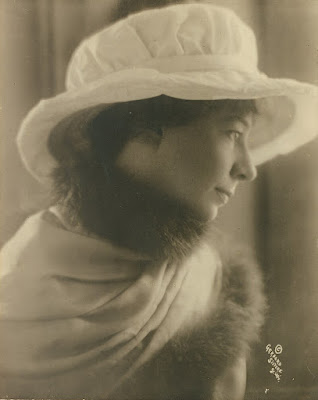 |
| Sara Teasdale. Photograph by Gerhard Sisters, ca. 1910 Missouri History Museum Photograph and Print Collection |
The Life and Loves of Sarah Teasdale; Kristin Dauphinais, Nigel Foster; London Song Festival at Hinde Street Methodist Church
Reviewed 14 November 2025
A chance to explore the work of an American poet not so well known in the UK along with a whole range of late 20th and 21st century American composers
The American poet Sara Teasdale (1884-1933) is perhaps not as well known in the UK as in the USA. Born into a wealthy family in Missouri, she would write seven books of poetry charting developments in her own life, from her experiences as a sheltered young woman in St. Louis, to those as a successful yet increasingly uneasy writer in New York City, to a depressed and disillusioned person who would commit suicide in 1933. Popular in her lifetime, Teasdale wrote poetry that used traditional forms with a reliance on metre and rhyme. It is worth bearing in mind that she was only four years older than T.S. Eliot and for a short period the two attended the same school!
There is a strong sense that Teasdale’s poetry was self-reflexive which made her a highly suitable subject for a recital which sought to elucidate Teasdale’s story via songs setting her poetry. At the London Song Festival at Hinde Street Methodist Church on Friday 14 November 2025, mezzo-soprano Kristin Dauphinais and pianist Nigel Foster did just that with The Life and Loves of Sara Teasdale. Dauphinais is based in Arizona where she teaches at the University of Arizona and the recital has also been presented there. The selection of songs focused on settings by 20th and 21st century American composers, giving us a selection whose work I had not heard before.
We had a mix of living and historical composers with music by Amy Beach (1867-1944), Wintter Watts (1884-1962), Katherine Glen, John Duke (1899-1984), Robert Baksa (1938-2023), and Simon Sargon (1938-2022) many of whom were effectively Sara Teasdale’s contemporaries, alongside contemporary composers Richard Pearson Thomas, George Crumb, Lori Laitman, Michael Ching, Zachary James Bramble, and Martha Helen Schmidt.
The recital took us through Teasdale’s life, with a focus on her personal relations. Brought up sheltered by her well-to-do family, she fell in love with fellow poet Vachel Lindsay in 1913. Lindsay is perhaps best known for his poem General William Booth Enters into Heaven. The relationship did not prosper because Lindsay, lacking family support, struggled to earn an income and felt he did not have the money or stability to support Teasdale. But her marriage to businessman Ernst Filsinger was not happy, and when they divorced in 1929, she found Vachel Lindsay had already married. Lindsay committed suicide in 1931, and Teasdale did so in 1933. Her later poetry is unflinching, with that sense of personal reflection from her earlier work, but she never seems to have veered from her fondness for traditional forms. Though, as with Emily Dickinson, there were moments when Teasdale’s slightly tart personal voice came over too.
Dauphinais alternated readings of Teasdale’s poetry with songs, giving us a dramatic presentation that suggested we were hearing the poems being read to us by the poet. She was fully invested in both the music and the recited words and it is to her credit that her recitations had as much dramatic credibility as the songs. However, being as we were not given printed words, I did sometimes struggle to apprehend the sung words and there was a sense that throughout the recital, in song Teasdale’s personality was lost somewhat.
Of the older composers in the programme, Amy Beach’s Message (from 1922) was unashamedly romantic, whilst both Wintter Watts’s Joy (1917), which was written for John McCormack, and Katherine Glen’s Tranquillity had a distinct feel of the salon about them. John Duke’s Central Park at Dusk (1947) and On a March Day (1947) had an intriguing quality to the harmony though his writing was very traditional, and he certainly knew how to write for the voice. Both Robert Baksa’s Did you ever know and Simon Sargon’s Let it be you brought a similar intriguing quality to their tonal writing. Baksa’s song with its romantic modernism and Sargon’s with its haunting, austere quality.
The two songs by George Crumb, Wind Elegy and Let it be Forgotten from Three Early Songs are something of a special case. Written when Crumb was only 18 the songs are terrific, yet nothing like the Crumb that we know. Wind Elegy was all evocative melancholy, whilst Let if be Forgotten was remarkably spare. Both were very effective and striking.
The other contemporary composers in the programme were all using different aspects of tonality. It was almost as if they were influenced by Teasdale’s use of traditional forms to create music that matched the songs. We heard two songs from Richard Pearson Thomas’s Spring Rain. The first, Child, Child was full of unashamedly lyrical passion, whilst Spring Rain contrasted this lyrical passion in the voice with more interesting textures in the piano.
There were three of Lori Laitman’s songs and all three had hints of musical theatre directness too them along with melodic felicity. The Metropolitan Tower was lyrically engaging, with a memorable melody, then Jewels allowed the song to be shaped by the text itself, whilst Nightfall had an intriguing intelligence in the lyricism. Michael Ching’s I know the stars seemed to have a similar influence from musical theatre, though the song turned rather questioning at the end.
Zachary James Bramble’s The Long Hill was a sequence of three Teasdale settings, two of which were written specifically for the recital. All three songs had a passionate restlessness to them, the middle song moving from musical theatre to something more disturbing, and the final one shading from lyric melancholy into something more disturbing. Martha Helen Schmidt’s A Little While also had a disturbing element to its lyricism as Schmidt’s music never seemed to quite settle, its restlessness mirroring the words.
The recital was a fine chance to get to know better a poet who had hitherto only been a name. As I have said, I would have appreciated being able to apprehend the words of the songs more, though Dauphinais and Foster were passionate in their commitment to the music. The programme gave us the opportunity to hear a whole range of 20th century and contemporary composers whose work is not so well known in the UK. That said, I think that having a greater variety in the choice of musical style might have helped and the occasional piece of grit in the oyster would I think have benefitted the programme.
The blog is free, but I’d be delighted if you were to show your appreciation by buying me a coffee.
Elsewhere on this blog
- The Rain Keeps Coming: Amelia Clarkson, the youngest female composer commissioned by the Ulster Orchestra, on her new work for them – interview
- Poetic exploration: Ensemble Près de votre oreille in an engaging exploration of chamber & vocal music by William Lawes – record review
- The other brother: music by Galileo Galilei’s younger brother on this lovely new EP – record review
- Fascinating, distracting & frustrating: Janáček’s Makropulos Case gets its first production at Covent Garden in Katie Mitchell’s farewell to opera – review
- James Blades: Pandemonium of the One-Man Band, James Anthony-Rose on his new music theatre piece on the great percussionist – interview
- A new solo album from British pianist, Alexander Ullman, features a thoroughly enjoyable selection of music by Edvard Grieg – record review
- Portraits of Mind: music by Ian Venables, Vaughan Williams & Butterworth in a celebration of Venables’ 70th birthday at Temple Music – review
- Small but perfectly formed: Wexford’s chamber version of Zemlinsky’s Der Zwerg still thrills and moves – opera review
- Vivid presence & engagement: Peter Whelan & Irish Baroque Orchestra in Bach’s Mass in B minor at Christ Church Cathedral, Dublin – concert review
- Home









